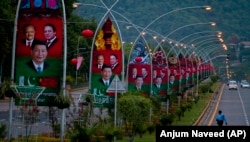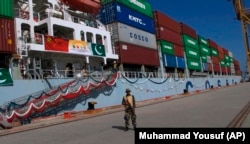A recent study of China's Belt and Road Initiative (BRI) in Pakistan suggests Beijing has less control over its massive development projects as was first thought and often has to alter its plans to accommodate Pakistani officials.
Since it was launched six years ago, the China-Pakistan Economic Corridor (CPEC) has become the centerpiece of the BRI, which aims to build infrastructure, expand trade links, and deepen ties across Eurasia and Africa.
Over the years, CPEC has morphed in size and scope, with Beijing already investing $25 billion and some estimates saying the bundle of energy and development projects could reach $62 billion once completed.
The far-reaching project has come to represent Beijing’s wider geopolitical ambitions, with CPEC forming the backbone of China's presence in Pakistan and symbolizing the “all-weather friendship” between the two countries.
But a study by the Carnegie Endowment for International Peace digs deeper into the internal machinery of how CPEC is unfolding on the ground, looking at negotiations between Beijing and Islamabad and how China has adapted its plans to suit the domestic situation within Pakistan.
“There is often an impression that the BRI happens with China parachuting its projects and plans into recipient countries that have very little say over how things happen on the ground,” Filippo Boni, one of the report’s authors and a lecturer at The Open University in Britain, told RFE/RL. “Whereas what we observed in Pakistan is that it’s much more complicated and the agenda and priorities of the recipient countries have huge sway over how things unfold.”
Beijing’s growing footprint in Pakistan through CPEC has made it one of the most visible case studies of China’s growing presence abroad and has led to accusations by critics that the grouping of projects is a tool for Chinese expansion and a way to impose its will on Islamabad.
But Boni and co-author Katharine Adeney’s research on CPEC highlights how Chinese actors have adapted the project to suit the evolving needs and desires of Pakistan’s political leadership and how Islamabad has shaped what kind of projects have been pursued over the years.
“China can’t just get its way through the local context as easily as some might suggest,” said Boni. “It’s about negotiations and mutual interest. China’s power has its limits, and it needs to adapt.”
Shaping CPEC
Plans for CPEC were first discussed in 2013. It officially launched two years later and has come to form a bundle of energy, infrastructure, and industrial projects in Pakistan.
According to Adeney and Boni, partisan politics in Pakistan have played a key role in forming CPEC, both in terms of its route and the types of projects that have been pursued.
In particular, they point to how former Pakistani Prime Minister Nawaz Sharif prioritized directing CPEC toward the Sindh and Punjab provinces in order to boost his party’s prospects during elections by providing investment to the politically important regions.
Similarly, Sharif pushed for CPEC’s early investments to go toward energy projects in the hope that ending the country’s electricity shortages could improve his reelection bid in 2018.
Pakistani politics have continued to play a role in forming CPEC under Prime Minister Imran Khan, who succeeded Sharif in 2018.
While Khan’s government expressed initial suspicion toward BRI and continues to worry about the long-term implications of becoming too dependent on China, CPEC has since been embraced as a much-needed boost to kick-start Pakistan’s economy at a time when Islamabad is struggling to attract international investors.
Khan’s government has also harnessed CPEC to shore up its own political base, choosing to establish a special economic zone in Khyber Pakhtunkhwa Province despite Beijing preferring different locations and feasibility studies showing other areas would perform better.
“Each government has used the CPEC in different ways for their own ends,” said Boni. “But both have seen it as a way to showcase and deliver on promises of development to the population.”
Perhaps the project within CPEC that has received the most notice is the Gwadar Port in southern Pakistan. The port has received much international attention because of its strategic location close to the Strait of Hormuz -- the world's most vital route for shipping oil -- and providing access for China to the Indian Ocean.
But as Adeney and Boni highlight, the port in Gwadar has been a priority for Pakistani governments for nearly two decades and predates the launch of the BRI.
“It’s not only about China’s strategic interests and geopolitical priorities, but Pakistan’s as well,” said Boni.
Rhetoric vs. Reality
While CPEC is a priority for both Beijing and Islamabad, the project continues to face numerous obstacles as it moves forward.
Many projects have fallen behind schedule or so far failed to deliver on the promised results. This has led to the Pakistani military taking greater control through the 2019 creation of the CPEC Authority -- a government body authorized to oversee BRI projects in Pakistan -- and Islamabad is looking to cede further authority to the military to implement CPEC.
But this too has brought blowback.
In August 2020, a report that Asim Saleem Bajwa, the retired general who heads the CPEC Authority and also serves as special assistant to Khan, sparked controversy after it alleged he used his influential position to help his family amass huge wealth.
Separatist and extremist groups in the country have likewise launched plans aimed at attacking CPEC and Chinese interests in Pakistan.
Baluch insurgents claiming to be aided by Sindhi separatists attacked Pakistan's stock exchange in June, and in 2018 three gunmen tried to enter the Chinese Consulate in Karachi before being killed in a shoot-out. The attack was later claimed by the Balochistan Liberation Army, a separatist group.
Despite these mounting obstacles, Boni says both Beijing and Islamabad have invested too much money and political capital to turn away from the CPEC.
“[CPEC] has many problems, but it is still going ahead,” said Boni. “China has invested money and credibility in Pakistan and progress on [CPEC] sends an important message about the wider state of the BRI.”










